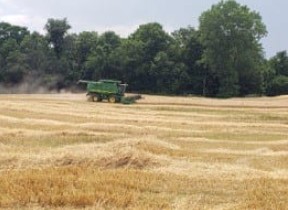For example, we finally received our food-grade research soybeans from Argentina in mid-June. We planted them right away, in the best field conditions we had all spring. The soybeans emerged in just four or five days. But after growing a few inches, they stopped, waiting for moisture to help them keep progressing.
All our other soybeans and corn need rain, as well. And once we get rain, our alfalfa will start growing again so we can do a second cutting of hay.
But while we wait for rain, we’ve had other work to do.
We harvested our winter wheat in early July, and the yields were better than we expected. That was encouraging. After the wheat was combined, we baled the wheat straw into square bales. My son-in-law David uses some of that straw as bedding for his cattle, and we sell the rest of it.

We have also been repairing damaged drainage tile in our fields. Our subsurface drainage has been in place for about 100 years. It consists of big, red clay tiles that were manufactured locally. These tiles, which look like clay tubes, were placed in trenches either 45 cm or 90 cm, or 18 inches or 3 feet, deep, dug by hand.
One of my landlords says that the original tile was the lower-quality pieces from the local manufacturer with slight imperfections or cracks – chosen to save money. Over time, those original imperfections have developed into cracks that can break and cave in, filling the tile with dirt. That creates a hole in the field. In fact, I broke an axel on a mower with one of them this season.
When we find these holes in the field, we mark them to repair when we have time and conditions allow, like now. If the broken tile is just 45 cm, or 18 inches, deep, we dig it out by hand. If the broken tile is 90 cm, or 3 feet, deep, we ask our neighbor to dig it up with his backhoe. In both cases, we pull out the damaged tile and clean out the neighboring tiles as much as possible. We shine a flashlight up and down the tube to note any other nearby spots that need repairing while we are there. Then we replace the damaged clay tile with plastic tubing, sealing it to fit into the older tiles on either side. It’s important to repair it correctly so the damaged spot doesn’t wash out again.
Our tiles follow the natural watershed flow of our land, with main tiles in the low areas where water is most likely to run. This subsoil drainage supports soil health and crop growth and helps minimize erosion. This is one way we improve our fields.
Click here to see more...